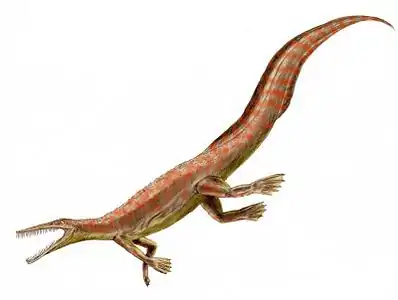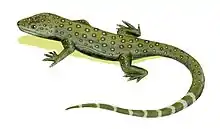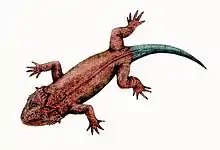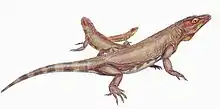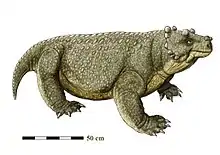Anthodon (reptile)
Anthodon (meaning "flower tooth") is an extinct genus of pareiasaurid parareptile from the Permian period of South Africa and Tanzania.
| Anthodon | |
|---|---|
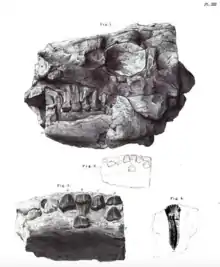 | |
| Skull of A. serrarius | |
| Scientific classification | |
| Kingdom: | Animalia |
| Phylum: | Chordata |
| Class: | Reptilia |
| Clade: | †Parareptilia |
| Order: | †Procolophonomorpha |
| Clade: | †Pareiasauria |
| Clade: | †Pumiliopareiasauria |
| Genus: | †Anthodon Owen, 1876[1] |
| Type species | |
| †Anthodon serrarius Owen, 1876[1] | |
| Species | |
| |
| Synonyms | |
| |
Description
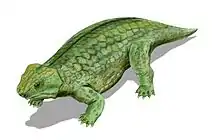
This small form combines the primitive feature of interpterygoid fenestra with an advanced feature of turtle-like armour. It was about 1.2 to 1.5 meters (3.9 to 4.9 ft) in length, and weighed around 80 to 100 kg (180 to 220 lb). Small dermal ossicles covered the body, while the pattern of armour plates on the back reminiscent of a turtle shell. The tail was further shortened relative to less derived forms. Some other forms are characterized by having smooth skulls and armor on the dorsal midline.
Skull
The skull was small, and the cheekbones unornamented as in other pareiasaurids.[2] The skull is 30 cm in length and quite lightly built. The cheekbones form very large quadratojugal "horns" that extend downwards to a great degree, but with a smooth unornamented surface. The mandible has ventral protrusions (further "horns"). The postparietals are fused and, along with the tabulars, located on the skull roof, as in more primitive diadectomorphs. There are 11 to 14 pairs of overlapping teeth, of small and uniform size, each with 8 to 15 cusps, giving them, as with all pareiasaurs, a leaf-like or flower like appearance, hence the generic name "flower tooth".
History
Richard Owen, who described Anthodon, thought it was a dinosaur because dinosaurian skull material from the Early Cretaceous had become associated with the Permian material. The dinosaur material was later separated out by Robert Broom in 1912 and was renamed as the stegosaurid Paranthodon by Franz Nopcsa in 1929.[3]
References
- Owen, Richard (1876). Descriptive and Illustrated Catalogue of the Fossil Reptilia of South Africa in the Collection of the British Museum. London: Taylor and Francis. pp. 14–15, 71. hdl:2027/nyp.33433090912332.
- Kazlev, M. Alan (2005-07-05). "Pareiasauridae". Kheper. Archived from the original on 2007-03-13. Retrieved 2007-10-09.
- Creisler, Ben (2003-07-07). "Dinosauria Translation and Pronunciation Guide P". DOL Dinosaur Omnipedia. Dinosauria On-Line. Archived from the original on 28 September 2007. Retrieved 2007-10-09.
